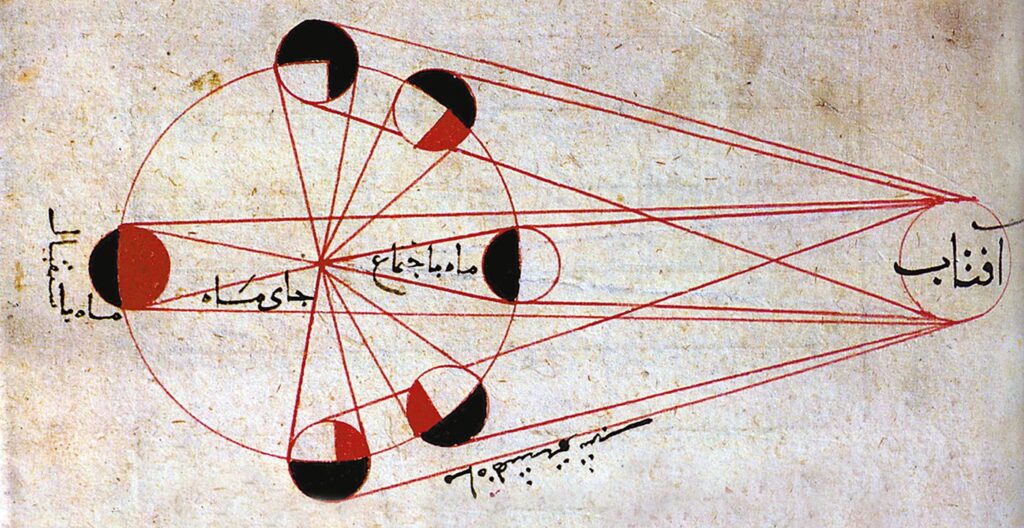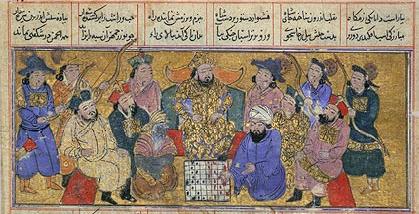Excerpts from my book: Swift Horses Sharp Swords with some additions
Indian knowledge, specifically Hindu, proved to be a deep ocean of scholarship that was absorbed into Islamic knowledge, either by stealing or by natural adaptation and friendly exchange. The Islamic golden age, if it can be called one, in the 9th century, could not have come without Hindu knowledge. Islamic knowledge later slowly seeped into Europe when Arabs ruled over Spain and triggered the Renaissance in the 15th century. Hindus can very well claim that the foundation of all the scientific, philosophical, and medical knowledge floating around in the world today was laid by them.
When Arabs were trying to expand their empire in the 8th century in India, they came across the prevalent Hindu numeral system. They adopted it wholesomely after replacing their own rudimentary Arabic numeral system called abjad. In 773 CE, a few Hindu astronomers, the most prominent of whom was Kanka, arrived at the court of Caliph al-Mansur in Baghdad, quickening the process of adaptation of the Hindu numerical system in the Arabic world.
Al-Qifti, an Egyptian historian, stated in his book, “Chronology of the Scholars” (early 13th century) about the furious developments in Indian mathematics happening until the 8th century:
… a person from India presented himself before the Caliph al-Mansur in the year 776 who was well versed in the siddhanta method of calculation related to the movement of the heavenly bodies, and having ways of calculating equations based on the half-chord [essentially the sine] calculated in half-degrees … Al-Mansur ordered this book to be translated into Arabic, and a work to be written, based on the translation, to give the Arabs a solid base for calculating the movements of the planets …
According to Al-Beruni, an Arab historian, India had multiple forms of numerals in the medieval era, and “Arabs chose among them what appeared to them most useful.” The first non-Indian reference to these numerals was made by Severus Sebokht, a bishop who lived in Mesopotamia about 650 CE. He noted the Hindu proficiency in astronomy, commenting, “As for their skillful methods of calculation and their computing, which belies description, they use only nine figures.” Arabs named the system al-hisab al-hindi.
In 820 CE, the famous Persian mathematician al-Khwarizmi wrote the book “On the Calculation with Hindu Numerals,” which was translated into Latin by Adelard of Bath (c. 1120) as Algoritmi de numero Indorum. When Al-Khwarizmi spread his numeral system to Europe, it transformed to the Arabic system from the Hindu numeral system. Persian astronomers al-Fazari and Yaqub ibn Tariq later published a book, “Zīj al-Sindhind” (“astronomical tables of Siddhanta”), which contains calendrical and astronomical calculations as well as a table of sine values. This was the first of many Arabic Zijes based on the Indian astronomical methods known as the sindhind. They kept using Ujjain as the centre point of the earth, just like we use Greenwich Mean Time as the standard time nowadays. If they had the requisite knowledge and wisdom, they could have used Baghdad as the focal point.
Sindhind is a detailed study of the movements of the sun, the moon, and the five planets known at the time. The work was the turning point in the history of Islamic astronomy, and soon it reached its zenith. Another work, Zij al-Shah is a collection of astronomical tables based on Indian astronomical parameters. Indian astronomer Brahmagupta had the most profound effect on Islamic astronomy, as most of his works were translated into Arabic in 773, when Indian scholars arrived in Baghdad. Many of the stars, like Mintaka, Alnitak, and Alnilam, the three stars that form Orion’s Belt, and astronomical terms like alidade, azimuth, and nadir, all have Arabic names. Tragically, no prominent star has a Hindu name.

Another Arab mathematician, Al-Kindi wrote another book, “On the Use of the Hindu Numerals” [kitāb fī isti’māl al-‘adād al-hindī] around 830 CE. The earliest book, Codex Vigilanus, containing Hindu numerals, was written in Spain in 976 CE. The advantages of this numeral system are so huge that they have been adopted almost everywhere. The system was the closest approach to a universal human language yet devised.
Yuval Noah Harari, in his book “Sapiens” (2011), asserted that the Hindus invented the numeral system:
A critical step was made sometime before the ninth century AD, when a new partial script was invented, one that could store and process mathematical data with unprecedented efficiency. This partial script was composed of ten signs, representing the numbers from 0 to 9. Confusingly, these signs are known as Arabic numerals even though they were first invented by the Hindus. But the Arabs get the credit because when they invaded India they encountered the system, understood its usefulness, refined it, and spread it through the Middle East and then to Europe. [p 146]
Around 500 CE, the astronomer Aryabhata used the word “kha” (“emptiness”) to mark “zero” in tabular arrangements of digits. He also used the concept of a place value system, first used in the 3rd-century Bakhshali Manuscript. The 7th-century Brahmasphuta Siddhanta also contains a comparatively advanced understanding of the mathematical role of zero. The first dated and undisputed inscription showing the use of a symbol for zero appears on a stone inscription found at the Chaturbhuja Temple at Gwalior in India, dated 876 CE. The Hindus had a fundamental concept of ‘nothingness” as an essential element of the universe dating back thousands of years in history. The evolution of this concept into a revolutionary mathematical symbol is a natural corollary. Arabs rendered shunya into sifr. In Europe, it began to be called “cifrae.” In the 13th century, Fibonacci called it zephir. From there, the term became zéro in French and, in English, zero.
In fact, modern trigonometric notations such as “sine” and “cosine” are also mistranscriptions of the words jya and kojya, first introduced by Aryabhata. As happened in other branches of mathematics, they were first translated as jiba and kojiba in Arabic which was misunderstood by Gerard of Cremona while translating an Arabic geometry text to Latin. Arabs even copied our calendars. The Jalali calendar, which is based on the Hindu Panchanga, is now a national calendar in Iran and Afghanistan.
Al-Tabari, a 9th-century Persian scholar and physician of Caliph al-Mutawakkil in Baghdad, wrote a book on medicine, Firdaws al-Hikmah (Paradise of Wisdom), in which Ayurveda found a special mention. He also referred to noted Indian physicians such as Charaka, Sushruta, Madhavakara, and Vagbhata II. Al-Kindi from Baghdad also wrote a medical book, Aqrabadhin (Pharmacology), a kind of Persian Materia Medica. It was copied from Hindu medicinal texts, as the described plants and drugs originated in India.
In 987, Arab historian Ibn Nadeem authored al-Fehrist, which had a list of 10,000 books and 2,000 authors who contributed to the growth of the Islamic golden age. Fehrist has a long list of Sanskrit manuscripts, to say the least.
In the 11th century, Al-Beruni analyzed the philosophy underlying Vedic texts and translated several of them into Arabic, including selections from Patanjali’s Yoga-Sutras, a philosophical compilation, and the 700-verse Bhagavad-Gita. In his own book, Kitab Ta’rikh al-Hind (Alberuni’s India), he went gaga over the Hindu intellectual culture. Panchtantra, a 3rd-century BCE fable on morals, was translated into Arabic with the pedestrian name Kalila wa Dimna (Kalila and Dimna) by Ibn al-Muqaffa in the 8th century.
Even in the Mughal period in 16th century, they did not stop copying our knowledge systems and even copied Hindu philosophy. Several major Hindu texts, such as the Mahabharata, parts of the Vedas, the Gita, Yoga-Vasistha, and Bhagavata Purana, were translated into Persian, a court language of the Mughals. The fundamental concept of these texts was that all components in the universe are interconnected and display a common unit. However, this was such deep knowledge, contrary to Islamic tenets, that they were unable to imbibe it.
Dara Shukoh translated some 50 major Indian works, among them the Upanishads, which, in his opinion, had the power to make people “everlasting, unsolicitous, and eternally liberated.” His translation was further translated into Latin in the 18th century by a Frenchman named Anquetil Duperron.
They even didn’t shy away from copying our games. Chess originated as Chaturang which became Chatrang in Persia and Shatranj in Arabia in the 8th century. When it reached Spain, it acquired the name ajedrez which gave rise to Chess.

Despite all this, they could imbibe only limited secular knowledge. Many homegrown Muslim scientists like Al-Razi, Ibn-e-Sina, Ibn-ul-Haitham, and Ibn-e-Rushd of the medieval age advocated reason, but their theories went against the Quran and were condemned to death for blasphemy. That’s why their contributions to science remained disproportionately insignificant, considering their wealth and power in the medieval era.
Probably ashamed of copying Hindu sciences, Muslim invaders intended to destroy all the major libraries in India to obliterate any such evidence. As Al-Beruni stated, the Islamic invasions made Hindu (and Buddhist) centers of learning their special targets:
“…Hindus became like atoms of dust scattered in all directions. …This is the reason too why Hindu sciences have retired far away from those parts of the country conquered by us, and have fled to places which our (Muslim) hands cannot reach.”
Written by Amit Agarwal, author of the history books, Swift Horses Sharp Swords & A Never-Ending Conflict.
Follow me on Twitter @amit1119 and Instagram/ Facebook at amitagarwalauthor.
You may buy my books at the following links:
https://garudabooks.com/a-never-ending-conflict-episodes-from-indic-resistance
https://www.amazon.in/dp/B0B6J5PKPR
https://garudabooks.com/swift-horses-sharp-swords-medieval-battles-which-shook-india-hindi (Hindi)
- How Hindu rituals spawned numerous advancements in science, maths and other arts - March 13, 2024
- Naga Sadhus and their fighting skills - February 20, 2024
- Lessons for India from the Israel-Palestine conflict - October 12, 2023

